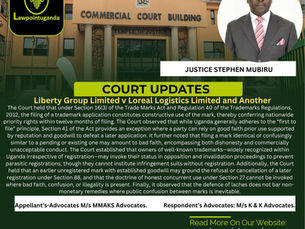top of page
BLOG POSTS
DISCLAIMER
This blog does not contain legal advice. The legal information is provided for general informational and educational purposes only and is not a substitute for professional advice. Accordingly, before taking any actions based on such information, we encourage you to consult with the appropriate professionals. Authors are liable for any plagiarism and Lawpoint Uganda won`t have liability towards the same.


"The existence of an earlier, unregistered Trade Mark with established goodwill can be a ground for refusal or cancellation of a later registration." Affirms the High Court of Uganda
The Court observed that Uganda operates a hybrid system prioritizing filing but recognizing prior good faith use (Section 41). The appellant's 2012 filing and 2006 use trumped the respondent's 2013 registration: "The 'first to file' principle in trademark registration grants exclusive rights to the applicant who files a trademark application first... By virtue of section 41 of The Trade Marks Act, first-to-use elements exist within what is primarily a first-to-file system...

Waboga David
Nov 69 min read


Court Slaps MK Publishers with UGX 100M Damages for Infringing Author's Children's Folktales, Affirms that Copyright Protection in Uganda Is Automatic Once an Original Work Is Fixed in Material Form.
The Court reaffirmed that under Section 13(3) of the Act, any assignment or license of copyright must be in writing and signed by the rights holder; implied consent or oral agreements are legally insufficient. The Court noted that MK Publishers altered, adapted, and sold four of the Plaintiff’s stories to the Government of Rwanda without any written license or authorization. The Court found that such unauthorized adaptation and reproduction constituted infringement of the Pla

Waboga David
Oct 28 min read


High Court Grants Anton Piller Order, Clarifying that Trademark Infringers May Conceal or Destroy Products if Alerted to Legal Action
As the Court warned: “It is likely that a party who markets and sells products under a trademark owned by another party may destroy and/or hide those products if it is alerted of the legal consequences of its conduct.”

Waboga David
Sep 34 min read


TAYLOR SWIFT–TICKETMASTER: MONOPOLY, ANTITRUST, AND LESSONS FOR UGANDA
Uganda faces some parallel concerns in its own economy. Monopoly control and platform dominance have shown up in sectors like telecommunications, banking, and digital finance. Until recently, Uganda’s framework for tackling such issues was fragmented and often weak. For example, telecom competition was governed by the Uganda Communications Act Cap 106 (as then), now Cap. 103 and its Fair Competition Regulations (2005).

Obita Calvin Stewart
Jul 710 min read


CHORDS, COPYRIGHT AND CREATIVITY - THE ED SHEERAN V MARVIN GAYE CASE
The lawsuit between Ed Sheeran and the estate of Marvin Gaye over the alleged copying of “Let’s Get It On” in Sheeran’s 2014 hit “Thinking Out Loud” crystallises this tension. This dispute, spanning several years and multiple courts, has become emblematic of the challenges in defining originality in music and the limits of copyright protection
Edgar Okitoi
Jun 307 min read


MONKEY CREATIVITY!?: AUTHORSHIP AND COPYRIGHT IN THE AGE OF NON-HUMAN CREATORS
The emergence of artificial intelligence has further complicated the debate over authorship and copyright. AI systems are now capable of generating original works of art, music, literature, and code, thus raising the question of whether AI can be considered an author, and if so, how should copyright law apply? The U.S. Copyright Office has however taken a firm stance against recognizing AI as an author, stating that copyright protection extends only to works created by human
Edgar Okitoi
Jun 258 min read


Is Artistic Freedom Safe in the NFT Age? Lessons from Hermès Int'l v. Rothschild
The Hermès v. Rothschild case therefore represents trademark law's attempt to re-establish control over the "real" and its signs in a hyperreal economy, asserting that even in the digital ether, the fundamental principles of preventing confusion and dilution must apply to maintain the integrity of established brands against unauthorized "simulacra."
Edgar Okitoi
Jun 2119 min read


Tom Waits v. Doritos: Vocal Identity, Misappropriation, and Lessons for Uganda's Intellectual Property Regulatory Framework.
The rise of artificial intelligence has dramatically transformed the landscape of voice imitation, making it possible to create highly realistic digital replicas of an individual’s voice, often without their knowledge or consent for example the Late Ugandan Artist, Moze Radio of GOODLYFE Music, there have been allegations of AI voice imitation of his likeness and vocal timbre.
Edgar Okitoi
Jun 29 min read


THE LOUBOUTIN V. YSL RED SOLE DISPUTE: FASHION, LAW, AND THE LIMITS OF TRADEMARK PROTECTION
A trademark must act as an indicator of origin, denoting from whom the goods or services came rather than what they are, that is why in Canon Kabushiki Kaisha v Metro Goldwyn - Mayer Inc court noted that the essential function of the trade mark is to guarantee the identity of the origin of the marked product to the consumer.
Edgar Okitoi
May 247 min read
Follow us:
bottom of page
























.jpg)
